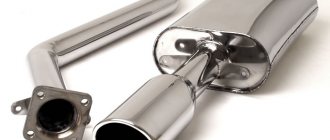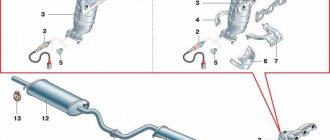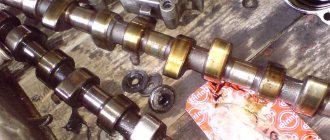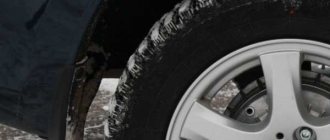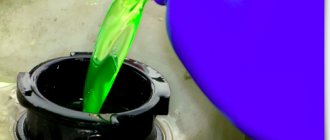An automobile system contains a certain number of different mechanisms.
The main function is the presence of an exhaust system, that is, the removal of already exhaust gases from the combustion chamber, which is present in the engine. As a rule, the operating temperature of all parts of the exhaust system varies not by tens, but by hundreds of degrees, so painting the muffler should be done as competently as possible. During the production process, such elements are treated with the most common high-quality anti-corrosion compounds. They are designed to effectively protect the metal from damage by destructive corrosion and from damage during transportation, since the coating burns very quickly when the engine is running.
ATTENTION! A completely simple way to reduce fuel consumption has been found! Don't believe me? An auto mechanic with 15 years of experience also didn’t believe it until he tried it. And now he saves 35,000 rubles a year on gasoline! Read more"
There is another risk factor, which is the contact of elements of the exhaust system with dirt and moisture. This usually happens while the vehicle is moving, since all such parts are mounted under the bottom of the car. Hot metal reacts to these factors much more than metal that is at rest.
The need to paint the muffler
Painting a car muffler is required not only to effectively protect this element from corrosion, but also to completely prevent the fairly rapid aging of the metal, which occurs under the strict influence of thermal shock. The outer part of the muffler is usually cooled under a certain influence of the ambient temperature. At the same time, in its internal part there is a negative impact of hot exhaust gases. Also, a certain amount of condensation forms in the muffler, which after some time causes corrosion.
Due to a fairly large number of unfavorable factors that affect a car, a muffler without high-quality protection will not last for a long time.
Content
What you need to paint a car
What paint is better to paint the muffler?
Preparing for the painting process
Coloring instructions
Recommendations from the author
To keep a part of one of the most important car systems in proper condition, you will need paint for the muffler.
It is best to use silver paint, which is what the muffler is coated with at the factory. The exhaust system is one of the main mechanisms for the correct and smooth operation of the entire vehicle. Its task is to remove exhaust gases that are formed in the combustion chamber. All parts of the system heat up during engine operation to very high temperatures, amounting to hundreds of degrees. The exhaust pipe, when heated, quickly becomes unusable, and the paint on it, under the influence of high temperatures, simply burns. This reduces the protection of metal parts, and they are subject to corrosion and other negative influences.
The pipe is located in the lower part of the car, therefore it is subject to the mechanical influence of sand and small stones that fall on it during movement. The action of chemical reagents also negatively affects the condition of the metal. Moisture is the main enemy of metal. Insufficient protection will lead to rust and damage the exhaust pipe very quickly.
During the manufacturing process of vehicles, parts are necessarily treated with high-quality anti-corrosion agents, however, high temperatures destroy the protective layer and to keep the car in the required condition, the protective layer must be regularly updated. Car owners who monitor the condition of their iron friend are always faced with the question of how to paint the car muffler.
To extend the life of the exhaust pipe, drivers resort to the following tricks:
- drilling holes for condensate to escape;
- painting the exhaust pipe with special paint that prevents corrosion.
One hole in the muffler body will be enough. The resulting condensate will drain through it, preventing the accumulation of water and rusting of metal parts.
Painting will serve as protection against rust and prevent rapid aging of the metal due to high temperatures, which can reach four hundred degrees.
What you need to paint a car
Painting a car is a very responsible process. It is best to use the services of special auto painting workshops. They have all the necessary equipment and materials. The work will be completed quickly, and you will be confident in the quality of the painting.
Pneumatic spray gun
If you still decide to carry out painting work, then before you start, you need to prepare the following equipment:
- spray gun;
- compressor;
- polishing machine or drill with attachments;
- mobile light source;
- construction hair dryer;
- grinding machine (grinder);
- personal protective equipment.
All of the above tools may not always be needed. A spray gun can easily replace canned paint if you don’t need to paint the entire car body. It is not advisable to purchase a hair dryer for painting individual parts. But gloves, a protective suit and a painting mask should not be neglected.
In addition to the necessary tools, the following materials are required to paint a car:
- abrasives;
- putty;
- priming;
- solvent and degreaser;
- dye;
- varnish
All painting materials should be purchased of high quality, preferably from trusted manufacturers. Following the instructions will help you avoid trouble and the work will not have to be redone. To understand the question of how to paint the muffler, you should know the features of this car part. Due to exposure to high temperatures, ordinary paint cannot be used to paint the exhaust pipe. It will quickly burn and the work will have to be done again. There is a wide selection of paint and varnish products from different brands on store shelves. Thermal paint for the muffler is the best option for painting this part.
What paint is better to paint the muffler?
Parts such as the muffler cannot be painted with the usual paint that we use to paint a car body. To get the best results and lasting effect, you should use heat-resistant paint. Some drivers use fireplace paint for painting work. But this is absolutely not rational. There are currently many special heat-resistant dyes on the shelves of auto stores.
Silicone-based heat-resistant paint for car mufflers has proven itself to be excellent. It can withstand high temperatures and has excellent durability. Apply in several layers, allowing to dry. There is no need to prime the surface before painting, which greatly simplifies the process.
There is a certain feature that distinguishes heat-resistant paint from regular paint. In order for it to dry, the surface after painting must be heated to a temperature of 160–200 degrees. If this is not done, the layer can be easily damaged. Because the paint will remain soft. It hardens only when heated. After painting, the muffler is heated to the desired temperature using a hairdryer. If you don't have one, you can use the oven. The time required to dry the layers is 15–20 minutes.
But the best option is to paint the calipers with silver enamel. Surely it has been tested and will not require large expenses.
Heat-resistant enamel KUDO
Preparing for the painting process
Any process, especially when it comes to painting, requires careful preparation. This is the only way to get the expected result, and the work will delight you for a long time. Cleaning the surface is the most important step, and if it is not done well enough, you may not waste effort on other processes. The result will be disastrous in any case.
The surface of the muffler should be cleaned of old coating and the metal should be free of rust and other contaminants. If traces of rust are not completely removed, the part will continue to rust, destroying both the part itself and the layer of paint on it.
Cleaning methods:
- Clean with a brush with metal bristles or a drill with cleaning wheels. If the rust has eaten a hole through the surface, cover it with a layer of putty.
- To remove the previous layer of paint, you can use chemical removers designed for this purpose. They can remove organic compounds and waterborne paints.
- Using a heat gun can cause the paint to bubble up and remove it easily.
If there is lead in the parts being processed, the gun cannot be used. The heating process provokes the evaporation of harmful substances, which is harmful to health. After thorough cleaning, the surface should be puttied. The final process is sanding.
Preparing to paint the muffler
Coloring instructions
The work of painting a muffler differs little from regular painting of a car body. The paint should be applied slowly, in thin layers, maintaining intervals between them. Be sure to ensure that no leaks form. It is best to carry out the work using a spray gun. It's easy and gives excellent results. It should be held exclusively straight. If you paint while pointing the spray gun at an angle, streaks and sagging will form on the surface of the muffler.
Drying is an important and integral step in the process. It takes a lot of time. Instead of an oven or hairdryer, you can dry the outer side of the part painted with heat-resistant paint by baking. This process can be entrusted to the engine of the car while it is moving.
Stages:
- Choose paint. Silicone-based enamel is perfect. It is distinguished by ease of application and quick drying process.
- Preparing the muffler for painting. Remove corrosion and old paint layers. The surface is cleaned using any convenient method.
- Direct painting. There should be several layers. Be sure to dry between applications.
- Dry the surface using a hair dryer or heat it at a temperature of 160–200 degrees.
Muffler painting
Recommendations from the author
A car muffler is a part that needs to be painted with particular seriousness. This is due to the fact that during operation it heats up to significant temperatures, and this makes it impossible to use ordinary paint for painting. The painting process is needed not only to give the muffler an aesthetically attractive appearance, but also to extend its service life by protecting it with a layer of paint from the negative effects of the external environment and preventing the rusting process.
By following all stages of preparation, application and drying, you are guaranteed to get an excellent result and achieve your goals. Do not forget to follow safety rules when working, and also monitor the expiration date of the materials used.
- Home / Exhaust system /
- Can mufflers be painted?
Can mufflers be painted?
The car muffler, just like the resonator, as well as other components of the exhaust system, are exposed to aggressive environments.
All this seriously affects their service life, so a completely reasonable question arises: how to protect the muffler and is it possible to paint the muffler? There are options for mufflers that already have a protective coating in the form of a layer of aluminum or a layer of zinc, not to mention expensive spare parts made of stainless steel. There is no particular point in applying paint to them, but it is quite possible to protect parts made of ordinary black steel. Among the aggressive influences, the most powerful are:
- temperature changes, especially in winter;
- changes in humidity and the presence of moisture in the exhaust;
- salts and reagents that melt ice and snow on roads in winter; they destroy car exhaust parts;
- minor mechanical damage (from small stones, debris, etc.);
If you paint a car muffler against these factors, you can temporarily protect the exhaust system.
How to protect the muffler from corrosion?
To get a more or less effective option for exhaust protection, you should correctly determine what to paint the car muffler with.
To do this, you should take high-quality heat-resistant paint. The temperature of the muffler may be more than 100 C, and the temperature of the collector may be more than 600-700 C. If you paint not only the muffler, then this must be taken into account! By the way, this is the paint that mufflers are painted at some manufacturing plants. The choice of what paint to use is yours, since there are many options on the market and many manufacturers for how to paint a car muffler.
And so, before painting the muffler you should:
- thoroughly clean the surface of the muffler, you can “sandblast”;
- treat the muffler with a rust converter;
- wash off the rust converter with water or carefully remove it with a rag;
- degrease with solvent (an important point);
- prime;
- paint the muffler, while applying heat-resistant paint, preferably from a spray bottle, to minimize smudges.
If you don’t have a spray bottle, you can paint the muffler with a regular brush, if you do it carefully.
Do I need to paint the muffler?
At manufacturing plants, mufflers are painted to give them a marketable appearance, and so that they look presentable until the time of sale.
As soon as the muffler is installed, its surfaces are exposed to aggressive conditions and the paint layer disappears quite quickly. It should also be taken into account that during installation the paint layer suffers from minor scratches or welding, which effectively negates such protection. The interior of the muffler is not coated with paint and is exposed to corrosion and temperature directly, so protecting only the outer surfaces with paint does not seem to be very effective.
Despite all this, a layer of paint, properly applied to the outer surface of the muffler, still protects it for some time, and this protection may well slightly increase the operating time of the part.
Whether or not to paint the muffler is up to you. If you want your muffler or any other component of your car exhaust system to serve you for a long time, then choose high-quality parts from manufacturers you trust.
What paint to paint the muffler?
The process of painting the muffler will not be a waste of time and money if you use special heat-resistant paint. In the process of choosing what to paint the muffler with, it is worth considering that this part of the system warms up to about a hundred degrees, as for the temperature of the collector, its temperature can reach 400 degrees.
Silicone-based muffler painting shows very good results. Such compositions do not require preliminary priming of the surface, but are applied strictly in several layers, where the time interval between each of them is from 5 to 10 minutes. This will help completely avoid leaks.
When using modern heat-resistant paints, it is imperative to calcinate them after application to the surface. Without this treatment, the paint will not harden, and the protective coating that is present on the muffler can be very easily damaged by metal wrenches during repair or installation, for example. In other words, painting a muffler includes mandatory high-quality heat treatment. For this purpose, you can use a special drying cabinet, or a hair dryer is also suitable.
The muffler is painted with heat-resistant varnish
The muffler is painted with heat-resistant varnish
In general, I bought gas-69 not so long ago.
He is many years old. Accordingly, there is a little rust, although the condition is excellent for its age. Question 1: Rust has grown, how to get rid of it and how to prevent it from growing again? Paint it and that's it? Question 2: I’ll remove rust on the plug, but how can I prevent it later? Do you need to cover it with something? Paint with something heat resistant. loose rust necessarily requires stripping down to metal or stable rye, after which pickling with a converter, preferably one with zinc, then thorough repeated washing with water, drying, primer with a converter, then painting. When you treat a rye stain, expose the paint to an area one and a half times larger, usually this is the amount already affected by the rye along the perimeter. but she will still appear in this place, the question is how long you can delay this process..
The Glushak is rusting while the muffin is standing still without work, clean it with a metal brush and continue driving, it will burn and everything will be as it should. When it completely rots, you put in another plug. Painting an already rusty muffler is a no-brainer.
In general, I bought gas-69 not so long ago. He is many years old. Accordingly, there is a little rust, although the condition is excellent for its age. Question 1: Rust has grown, how to get rid of it and how to prevent it from growing again? Paint it and that's it? Question 2: I’ll remove rust on the plug, but how can I prevent it later? Do you need to cover it with something? Paint with something heat resistant.
The easiest way to deal with rust on a Glushak is to actually fight the Glushak itself. For the third time, my Glushak looked like this, it went off with a bang ;): https://www.a-stone.ru/other/glushak.jpg
I don’t know how the Glushak survives until it rusts :)))))
In general, I bought gas-69 not so long ago. He is many years old. Accordingly, there is a little rust, although the condition is excellent for its age. Question 1: Rust has grown, how to get rid of it and how to prevent it from growing again? Paint it and that's it? Question 2: I’ll remove rust on the plug, but how can I prevent it later? Do you need to cover it with something? Paint with something heat resistant.
You can extend the life of the muffler by covering it with heat-resistant paint. But not for long, because... As a result of temperature changes, the paint will fly off, as well as exposure to dirt, water, etc.
Painting a Glushak is something of a joke.
The army also paints grass noona;)
And the rust is very much from experience. It’s difficult to do well - after every winter (when parking on the street in Moscow) new old spots begin to come out.
Painting a Glushak is something of a joke.
The army also paints grass noona;)
And the rust is very much from experience. It’s difficult to do well - after every winter (when parking on the street in Moscow) new old spots begin to come out. Not really funny, the mufflers on foreign cars are painted. In the Southern Port they sell special heat-resistant paint. I buy it regularly (for work, not for muffler). But for UAZ, I agree, it’s useless. This is the second time that my muffler lasts for one year. Just replaced another one yesterday. Due to sloppy welding, the internal partition comes off, the muffler turns into a direct-flow muffler, and the outside is still almost like new. PS But actually, just for fun, you can paint it.
. PS But actually, just for fun, you can paint it. well, yes, in bloody color;)
If you drive decently, then there’s no point in painting it, but if it’s 4 hours a week, it won’t have time to burn in the parking lot!
Preparing for the painting process
During preparatory work, special attention should be paid to cleaning the paint from old enamel. Neglecting advice may result in poor quality painting. It is especially important to completely remove all traces of corrosion and rust.
There are several options for removing such plaques:
- You can use a very stiff brush with high-quality wire bristles to clean the surface. If there is an area of pinpoint damage from destructive corrosion on the surface, it is worth treating it with epoxy putty;
- A conventional scraper can provide relatively good results. This device is used in the process of preparing various parts for the painting process. If you are processing a relief surface, you should use special shaped scrapers. To significantly speed up the process, it is recommended to use a special grinding machine;
- If it is necessary to remove a layer of old paint from the muffler, effective chemical removers can be used. They are ideal for cleaning surfaces from various water-borne paints, as well as organic compounds;
An ordinary heat gun is perfect for high-quality cleaning of a car muffler, but it must be used very carefully. As soon as the paint swells and peels, it must be carefully removed.
This method is not suitable for parts that are made from materials that contain large amounts of lead, since during the heating process the latter can begin to evaporate quickly, which is very dangerous for the health of the person who is carrying out the painting process.
Instructions for painting the muffler
First, you should remove the part from the car and evaluate its general technical condition. It is important to find all areas of rust and clean them, as well as carefully remove the old coating that has begun to crumble. The service life of the new coating, its strength and the effectiveness of corrosion protection will depend on the quality of this work.
Preparing for work
Preparatory activities can be carried out using different tools and methods. In any case, after preparation is completed, the metal should be clean, without traces of paint, rust, dirt, or oil. If corrosion particles remain on the muffler, the rusting process will continue under the paint layer. After stripping the metal, it is puttied with special epoxy materials.
Paint a car muffler with silver
why does it rust on the inside?
Because condensation constantly forms inside.
I coated my muffler with Zinc spray from Wurth. It’s true that one balloon costs 500 rubles
why does it rust on the inside?
Because condensation constantly forms inside.
I coated my muffler with Zinc spray from Wurth. It’s true that one balloon costs 500 rubles
as soon as I buy it I’ll stick it in))))
Buy a muffler made of aluminized steel and does not steam
The muffler burned out from inside. When purchasing a new one, they recommended drilling a hole with a diameter of no more than 2 mm / supposedly to prevent condensation from accumulating /. Has anyone tried this method?
The muffler burned out from inside. When purchasing a new one, they recommended drilling a hole with a diameter of no more than 2 mm / supposedly to prevent condensation from accumulating /. Has anyone tried this method?
Dip into a bath of craft glue - aka liquid glass. Old grandfather's way.
A stainless steel muffler for 2500 rubles rules. not painted but shiny. The only problem is that the stainless steel is missing inside. because in five years you will still have to change it. since there will be only one jar of dust left.
and the hole was drilled from the factory, probably 6 mm. The specific sound she makes is like farting.
A stainless steel muffler for 2500 rubles rules. not painted but shiny. The only problem is that the stainless steel is missing inside. because in five years you will still have to change it. since there will be only one jar of dust left.
and the hole was drilled from the factory, probably 6 mm. The specific sound she makes is like farting.
I hear these words about stainless steel from more than one person. Have you checked it to see what it's made from? Yes, its shine is similar to stainless steel, but in fact it is ordinary rusting metal. Touch it with a magnet and you will understand.
I had a six from '82, there was a rear tank made of stainless steel, only the pipe that connected to the middle part was normal on it. Glushak looked like new after 20 years. Nowadays no one makes silencers from stainless steel. It will be very expensive and there will be no profit, since in 20 years I have not had a hint of burnout and laughing. Imagine, this will be an eternal muffler.
Source
